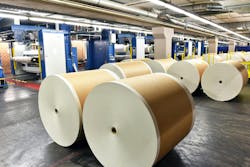Brillouin spectroscopy: A perspective into industrial applications
The intrinsic viscoelastic properties of materials are crucial parameters to evaluate for multiple industrial fields, including manufacturing, construction, food packaging, cosmetics, and others. Our goal is to define the viscoelastic properties to efficiently boost engineering design and materials development and perform proper quality control.
Making products like perfumes, detergents, or pesticides is not just about finding a suitable active ingredient—effectiveness and customer appeal are also important. With a water-like viscosity, a shampoo would be challenging to handle, or a pesticide would be washed away by the next bit of rain. For product development and quality control, it is crucial to get access to the product's viscoelasticity—but it is not easy.
In a world dominated by rheometers, viscometers, and nanoindenters, Brillouin spectroscopy is gaining momentum in the field of analytical instrumentation for viscoelastic measurements. As an all-optical technology, it is based on Brillouin light scattering from spontaneous acoustic waves (or phonons) in the gigahertz range to provide a microscale all-optical, label-free, and nondestructive probe of the micromechanics.1 A noncontact approach could offer a viable alternative to the standard elastography methods needed for mechanical characterization in diverse industrial applications.
Industrial applications
Pharmaceutical products can be liquid, semi-liquid, or solid, and accessing their viscoelastic properties allows drug producers to affect how a drug is formulated and developed directly. This capability helps determine drug efficacy, the quality of the raw components, dosage form, and, ultimately, the quality of the finished product. A nasal spray, for instance, must demonstrate specific mechanical properties to effectively deliver the active ingredient. Stress and strain measurements are essential for developing materials to restore tissue, muscle damage, or dermatological products where sensory characteristics or spreadability are a priority. Instrumentation providing access to these characteristics can help pharmaceutical companies accelerate product development.2
Brillouin spectroscopy could potentially provide viscoelastic monitoring of the different fabrication steps of pharmaceutical products—allowing real-time adaptations and ensuring reproducibility with minimal sample waste. It also has the potential to help explore new therapies. In cancer, for example, evidence has shown that an increased extracellular matrix stiffness may limit cellular invasiveness in other tissues.3–4 Brillouin spectroscopy can help scientists better understand the interplay between cell-matrix interactions in cancer development and progression, enabling the development of targeted and effective drugs and therapies.
The properties of materials involved in bioapplications must be highly controlled to predict and understand their interaction with cells. For instance, the materials used to develop surgical implants and prosthetic devices require mechanical properties adaptable to their biological environments.5 A straightforward example is hydrogels, which are promising soft biomaterials for biomedical applications such as regenerative medicine, tissue engineering, medical implants, targeted drug delivery systems, and wound healing.6–9 Brillouin spectroscopy enables fast, real-time, and nondestructive assessment of the mechanical properties. This is essential when living cells and tissues are the sample under test, facilitating continuous monitoring and minimizing sample waste.
Whether it is a cream, ointment, spray, foam, or gel, consistently delivering the highest quality cosmetics and personal care products is challenging. Reliable measurement apparatuses of viscoelastic properties are required since, through that measurement, the long-term physical stability of emulsions can be assessed and predicted.10 Most personal care products have a relatively short life span, and their development should be fast. Accelerated storage testing is needed to predict the formulations' long-term physical stability and consistency changes with time. A Brillouin viscoelastic sensor could be integrated into the fabrication lines to continuously monitor the product and facilitate the automation of the fabrication process, and ensure high quality and optimum texture.
Understanding the behavior of different food products through viscoelastic measurements can help food scientists develop new formulations that meet consumer preferences. From the simple viscoelastic properties' characterization of a liquid or semi-solid material to breaking tests of solid products, viscoelastic measurement apparatuses could provide the means needed to investigate raw materials and finished food products comprehensively.11 Brillouin spectroscopy could help the food industry ensure high-quality products by constantly monitoring their viscoelastic properties. It would also automate production lines and increase fabrication process control through various steps.
Polymers are extensively used across various industries, such as civil engineering, aerospace, and industrial machinery, where they play crucial roles in vibration control, dampening, and insulation. Rubber, for instance, is widely used in automobiles thanks to its effective damping properties and stress relaxation behavior.12 Analyzing the micromechanical properties of polymers helps establish relationships between molecular and supermolecular structure (morphology). This analysis can help study a polymer's lifecycle—from its development in the R&D lab to quality control during production.13 Brillouin spectroscopy can provide easy-to-use, reliable quality testing tooling—ensuring the final product's performance and increasing customer satisfaction.
The adhesion of function layers, the strength of wire bonding, and the scratch resistance of protective coatings are key areas of importance for semiconductors. Having instrumentation to characterize mechanical properties at a microscale level is essential. Brillouin spectroscopy could provide a solution for fast, real-time, and accurate assessment of the micromechanical properties of each structure onto a wafer without risking alternating the properties or mitigating the performance of the microstructure.
Glass was recently envisioned as a more robust alternative to silicon in microelectromechanical system (MEMS) applications, including high-frequency resonators and switches.14 Identifying the dynamic mechanical properties of microscale glass is vital for understanding its ability to withstand shocks and vibrations. Furthermore, three-dimensional (3D) glass micromanufacturing is the new standard for glass microdevices for life tech, medtech, optics, photonics, luxury/watchmaking, micro-optics, illumination, R&D, and others.
Keeping track of the micromechanical properties of the materials used during the process is crucial to enhance the product yield and meet customer requirements. Brillouin spectroscopy can assess viscoelastic characteristics in real time. For real-life applications, it can provide critical insights into material aspects, such as damage tolerance and crashworthiness.14 With its nondestructive nature, Brillouin spectroscopy enables mass production testers to ensure each product's quality before delivering to the customer.
With highly structured fluids like paints, inks, adhesives, and coatings, many components affect the flow behavior of the final product. And binders influence properties such as gloss, durability, flexibility, and toughness. Comprehensive testing is important to evaluate the rheological performance of paints, inks, and coatings to optimize formulations and ensure consistency among batches. Installing a Brillouin spectrometer at crucial points of the production line would automate process monitoring—ensuring high-quality products while minimizing waste.
The crucial function of lubricants in overcoming friction in metallic engines contributes to reducing global energy consumption. Effective lubrication in internal combustion engines helps reduce fuel consumption, which increases the overall energy efficiency and reduces the carbon emissions of vehicles—enabling the transition towards sustainability. Viscosity plays an important role in the lubrication process, which makes monitoring the viscoelastic properties of a lubricant crucial. Technologies and instrumentation that can access the viscoelastic properties of lubricants during the various production steps and in their final form to ensure their optimum performance is of high importance. Brillouin spectroscopy could ensure higher product quality and support the development of new materials.
As an all-optical technique, Brillouin spectroscopy can retrieve physical and mechanical properties, which can potentially be used for remote sensing. Notably, the technique has already been applied to remotely sense seawater temperature and salinity profiles by a Brillouin LiDAR system.15 This system uses time-of-flight information to measure the depth and relies on Brillouin spectroscopy as the temperature and salinity indicator. With accuracy in measuring the temperature of 0.5°C and the salinity of 1‰, a Brillouin LiDAR is a strong candidate for seawater remote sensing over long (>40 m) distances. Beyond this, Brillouin fiber sensors can provide distributed strain and temperature measurements over long distances in standard off-the-shelf fiber by measuring the Brillouin frequency shift as a function of position along a fiber.16, 17
In papermaking, the formation of bonds between single-pulp fibers is influenced by the hardness of the fibers in their wet state. Brillouin spectroscopy could characterize the mechanical properties of paper pulp and other cellulosic fibers—significantly improving the fabrication processes by reducing costs and shortening the fabrication cycle. It could be a game-changer for pulp and paper research and has the potential to become a standard test to evaluate fiber properties.18, 19
With paintings, sculptures, and artifacts crafted from various materials and colored with different types of paints like oil- or water-based, proper handling during cleaning and restoration processes is of utmost importance. Brillouin spectroscopy proves effective in predicting the physical and micromechanical properties of the object, supporting art restorers in ensuring that during cleaning procedures, the risk of potential damage to the artifact is minimized.20 In addition, analysis of the structural properties could offer the basis for a better understanding of oil painting degradation. No other technique can retrieve the micromechanical properties in a noncontact fashion nondestructively, which makes Brillouin spectroscopy the sole alternative for this kind of analysis in the precious objects of art and cultural masterpieces.
Bottom line
Brillouin spectroscopy is emerging as an alternative method to measure viscoelastic properties in the industrial sectors. Its potential for higher accuracy, real-time, and nondestructive measurements make it a viable alternative to the traditional, time-consuming and expensive elastography methods currently used for characterizing the micromechanical properties of materials in diverse industrial applications.
REFERENCES
1. R. Prevedel, A. Diz-Muñoz, G. Ruocco, and G. Antonacci, Nat. Methods, 16, 10, 969–977 (2019); doi:10.1038/s41592-019-0543-3.
2. H. Patil, R. V Tiwari, and M. A. Repka, AAPS PharmSciTech, 17, 1, 20–42 (2016); doi:10.1208/s12249-015-0360-7.
3. V. Gkretsi and T. Stylianopoulos, Front. Oncol., 8 (May 2018); doi:10.3389/fonc.2018.00145.
4. G. Antonacci et al., Nat. Commun. (2024); https://doi.org/10.1038/s41467-024-49419-2.
5. P. Moshayedi et al., J. Biomater., 35, 13, 3919–3925 (Apr. 2014); doi:10.1016/j.biomaterials.2014.01.038.
6. H. Geckil, F. Xu, X. Zhang, S. Moon, and U. Demirci, Nanomed., 5, 3, 469–484 (2010).
7. C. E. Hoffler, X. E. Guo, P. K. Zysset, and S. A. Goldstein, J. Biomech. Eng., 127, 7, 1046–1053 (Aug. 2005); doi:10.1115/1.2073671.
8. M. Beil et al., Nat. Cell Biol., 5, 9, 803–811 (2003).
9. W. F. Liu and C. S. Chen, Mater. Today, 8, 12, 28–35 (2005).
10. T. Tadros, Adv. Colloid Interface Sci., 108–109, 227–258 (May 2004); doi:10.1016/j.cis.2003.10.025.
11. S. Tariq, A. J. Giacomin, and S. Gunasekaran, Biorheol., 35, 3, 171–191 (May 1998); doi:10.1016/s0006-355x(99)80006-7.
12. I. D. Fatima, N. Shafi, and H. Anjum, Proc. ICAEM, 117–121 (2019); doi:10.1109/icaem.2019.8853764.
13. A. Sakhnevych, R. Maglione, and F. Timpone, Sensors, 23, 22 (2023); doi:10.3390/s23229213.
14. R. Ramachandramoorthy et al., Nano Lett., 19, 4, 2350–2359 (Apr. 2019); doi:10.1021/acs.nanolett.8b05024.
15. Y. Wang, Y. Xu, P. Chen, and K. Liang, Sensors, 23, 1 (2023); doi: 10.3390/s23010446.
16. J. B. Murray, A. Cerjan, and B. Redding, Optica, 9, 1, 80–87 (2022); doi:10.1364/optica.435716.
17. Y. Muanenda, C. J. Oton, and F. Di Pasquale, Front. Phys., 7 (Oct. 2019); doi:10.3389/fphy.2019.00155.
18. C. Ganser, U. Hirn, S. Rohm, R. Schennach, and C. Teichert, Holzforschung, 68, 1, 53–60 (2014); doi:10.1515/hf-2013-0014.
19. K. Elsayad et al., Cellulose, 27, 8, 4209–4220 (May 2020); doi:10.1007/s10570-020-03075-z.
20. M. Alunni Cardinali et al., Sci. Adv., 8, 26 (Jul. 2022); doi:10.1126/sciadv.abo4221.
About the Author
Panagiotis Vergyris
Dr. Panagiotis Vergyris is executive director at Specto Photonics (Milan, Italy). He has a Ph.D. in Quantum Photonics and more than 10 years’ experience in the photonics industry, with technical, managerial, and business roles in different deep-tech companies. Before joining Specto Photonics, he was a photonics program manager at the European Photonics Industry Consortium (EPIC), supporting startups in photonics, orchestrating successful business matches, and supporting and ensuring the viability of the European photonics ecosystem.
Giuseppe Antonacci
Giuseppe Antonacci holds a Ph.D. in Brillouin Spectroscopy and is the main founder of Specto Photonics. He is one of the scientific leaders in the field, with several publications in well-recognized journals. Giuseppe has worked as a project leader at imec, consolidating his knowledge in silicon photonics and photonics chip packaging. He currently remains an active physics researcher at the Politecnico di Milano while assuming the role of CEO and scientific director at Specto Photonics.






